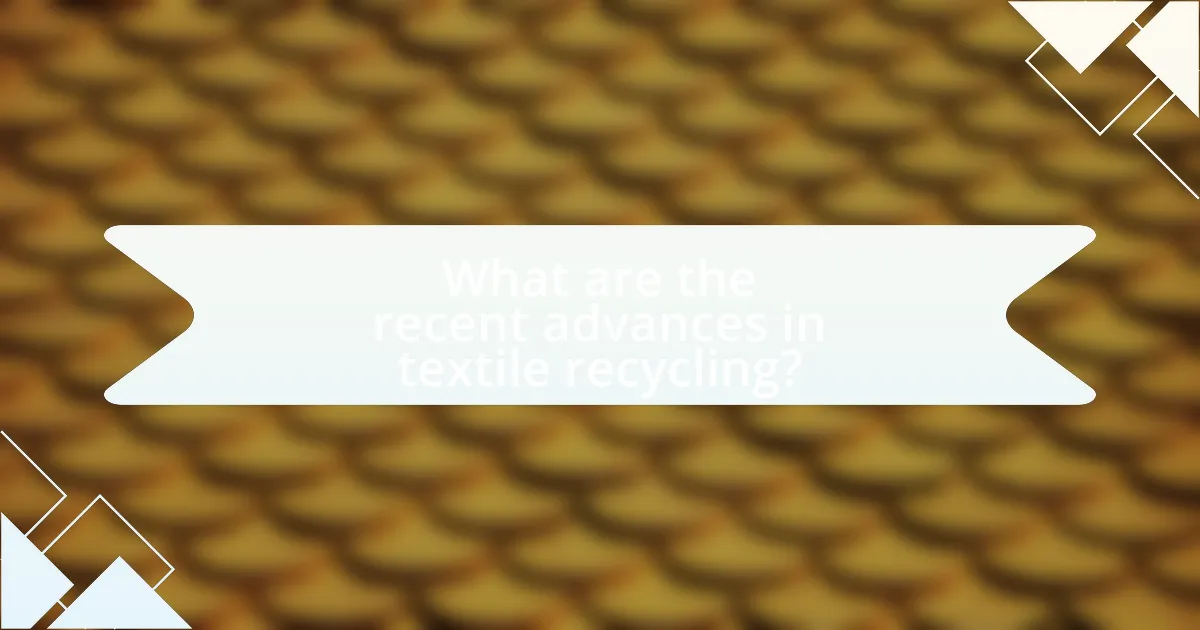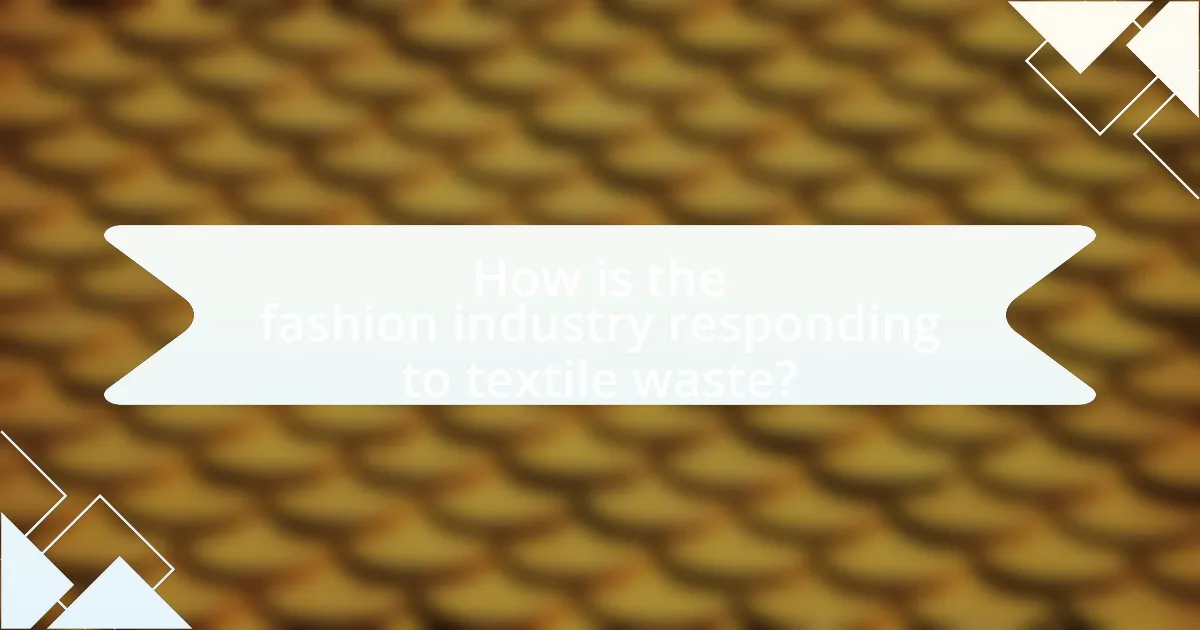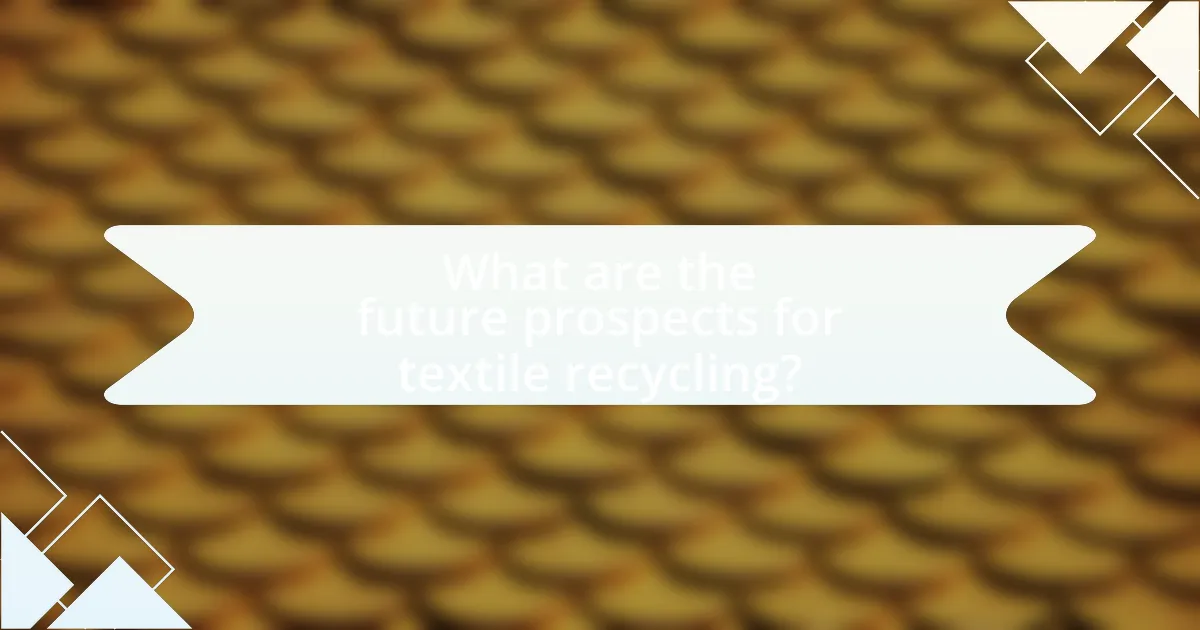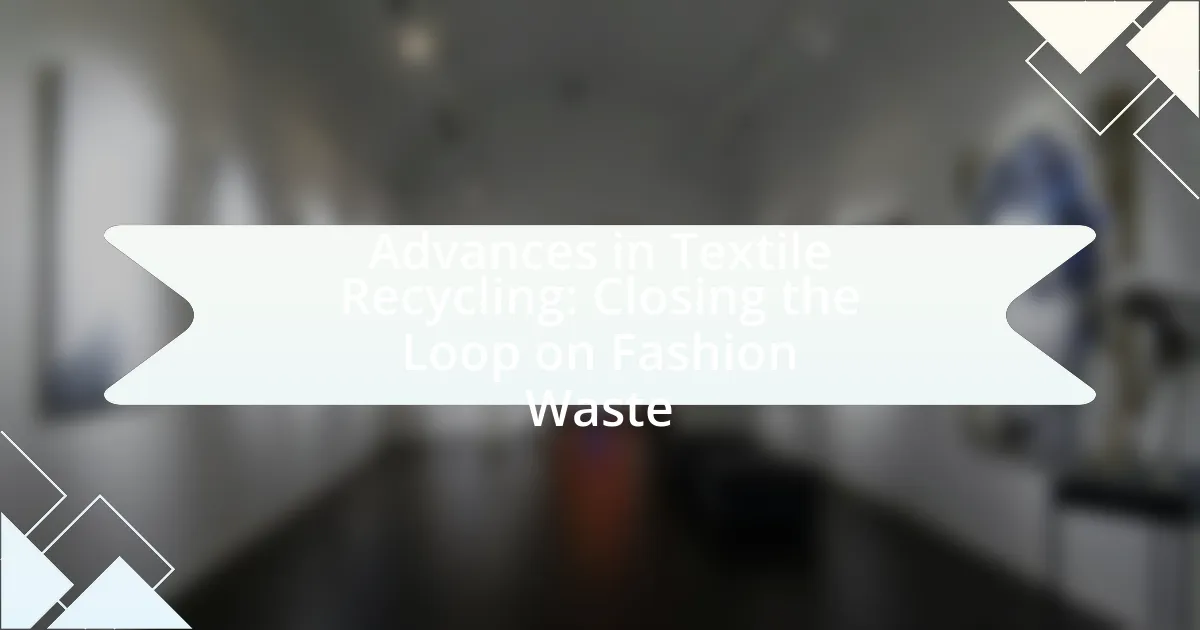The article focuses on recent advances in textile recycling, highlighting innovative technologies such as chemical recycling, enzymatic processes, and advanced sorting systems that enhance recycling efficiency. It discusses the importance of textile recycling for the fashion industry, addressing environmental benefits, economic barriers, and consumer behaviors that impact recycling efforts. Additionally, it examines the role of major fashion brands in promoting sustainable practices and the potential for policy changes to support recycling initiatives. The article concludes with insights into future prospects for textile recycling, emphasizing the significance of circular economy principles and emerging trends in technology.

What are the recent advances in textile recycling?
Recent advances in textile recycling include the development of chemical recycling technologies that can break down polyester and other synthetic fibers into their original monomers, allowing for the creation of new, high-quality fibers. For instance, companies like Eastman and Renewcell have pioneered processes that enable the recycling of blended textiles, which were previously difficult to recycle. Additionally, innovations in enzymatic recycling are emerging, where enzymes are used to decompose fabrics at a molecular level, enhancing the efficiency of recycling processes. These advancements are crucial as they address the growing issue of textile waste, with the global textile recycling market projected to reach $5 billion by 2025, reflecting a significant shift towards sustainable practices in the fashion industry.
How have technological innovations impacted textile recycling?
Technological innovations have significantly enhanced textile recycling by improving the efficiency and effectiveness of the recycling processes. Advanced sorting technologies, such as automated optical sorting systems, enable the rapid identification and separation of different fabric types, which increases the purity of recycled materials. For instance, a study by the Ellen MacArthur Foundation highlights that these innovations can boost recycling rates by up to 30%, allowing for a more sustainable circular economy in the fashion industry. Additionally, innovations in chemical recycling methods, such as the use of enzymes to break down polyester, have made it possible to recycle materials that were previously deemed non-recyclable, thus expanding the range of textiles that can be processed.
What specific technologies are being developed for textile recycling?
Specific technologies being developed for textile recycling include chemical recycling processes, mechanical recycling methods, and innovative sorting technologies. Chemical recycling involves breaking down textiles into their original fibers using solvents or enzymes, allowing for the creation of new fabrics from recycled materials. Mechanical recycling focuses on shredding and reprocessing textiles into fibers, which can then be spun into new yarns. Advanced sorting technologies utilize AI and machine learning to improve the efficiency of separating different types of textiles, enhancing the overall recycling process. These technologies are crucial for reducing textile waste and promoting sustainable practices in the fashion industry.
How do these technologies improve recycling efficiency?
Technologies improve recycling efficiency by automating sorting processes and enhancing material recovery rates. For instance, advanced sorting technologies like near-infrared spectroscopy and artificial intelligence can accurately identify and separate different textile materials, reducing contamination and increasing the purity of recycled fibers. According to a study by the Ellen MacArthur Foundation, implementing these technologies can lead to a 30% increase in recycling rates for textiles, thereby significantly reducing waste and resource consumption in the fashion industry.
Why is textile recycling important for the fashion industry?
Textile recycling is crucial for the fashion industry because it significantly reduces waste and conserves resources. The fashion industry is one of the largest polluters globally, with approximately 92 million tons of textile waste generated annually, according to the United Nations. By recycling textiles, the industry can divert waste from landfills, decrease the demand for virgin materials, and lower carbon emissions associated with production. Furthermore, recycling can recover valuable fibers and materials, promoting a circular economy that enhances sustainability and reduces environmental impact.
What environmental benefits does textile recycling provide?
Textile recycling provides significant environmental benefits by reducing landfill waste, conserving natural resources, and lowering greenhouse gas emissions. By recycling textiles, approximately 92 million tons of waste are diverted from landfills annually, which helps mitigate the environmental impact of waste disposal. Additionally, recycling one ton of cotton can save around 7,000 gallons of water, highlighting the conservation of vital resources. Furthermore, textile recycling can reduce carbon emissions by up to 50% compared to producing new textiles from virgin materials, contributing to climate change mitigation.
How does textile recycling contribute to sustainability in fashion?
Textile recycling significantly contributes to sustainability in fashion by reducing waste and conserving resources. By recycling textiles, the fashion industry can divert millions of tons of clothing from landfills, where they would otherwise take years to decompose. According to the Environmental Protection Agency, in 2018, approximately 11.3 million tons of textile waste were generated in the United States alone. Recycling these materials not only minimizes landfill contributions but also decreases the demand for new raw materials, thereby conserving water, energy, and natural resources used in the production of new textiles. For instance, producing recycled polyester uses up to 59% less energy compared to virgin polyester production. This process also lowers greenhouse gas emissions, contributing to a more sustainable fashion ecosystem.
What challenges does the textile recycling industry face?
The textile recycling industry faces significant challenges, including contamination of materials, lack of infrastructure, and economic viability. Contamination occurs when non-recyclable materials are mixed with textiles, making the recycling process more complex and costly. The lack of adequate recycling infrastructure limits the collection and processing of textile waste, resulting in a lower recycling rate; for instance, only about 15% of textiles are recycled globally. Economic viability is hindered by fluctuating market prices for recycled materials, which can deter investment in recycling technologies and facilities. These challenges collectively impede the industry’s ability to effectively close the loop on fashion waste.
What are the economic barriers to effective textile recycling?
The economic barriers to effective textile recycling include high processing costs, insufficient market demand for recycled materials, and the lack of financial incentives for recycling initiatives. High processing costs arise from the need for advanced technology and infrastructure to sort and recycle textiles efficiently, which can deter investment. Insufficient market demand for recycled textiles limits the profitability of recycling operations, as manufacturers often prefer cheaper virgin materials. Additionally, the lack of financial incentives, such as subsidies or tax breaks for recycling businesses, further hampers the growth of the textile recycling industry. These factors collectively create a challenging economic environment that inhibits effective textile recycling efforts.
How do consumer behaviors affect textile recycling efforts?
Consumer behaviors significantly influence textile recycling efforts by determining the volume and quality of materials available for recycling. When consumers prioritize sustainable practices, such as purchasing second-hand clothing or actively participating in recycling programs, they increase the supply of textiles that can be recycled. For instance, a study by the Ellen MacArthur Foundation found that if clothing utilization were to increase by just 1 year, it could reduce carbon, water, and waste footprints by 20-30%. Conversely, consumer tendencies towards fast fashion and disposable clothing lead to higher waste generation, making recycling more challenging. Thus, consumer choices directly impact the effectiveness and efficiency of textile recycling initiatives.

How is the fashion industry responding to textile waste?
The fashion industry is responding to textile waste by implementing innovative recycling technologies and adopting circular economy practices. Brands are increasingly investing in textile recycling initiatives, such as using recycled materials in new collections and developing take-back programs that encourage consumers to return used garments. For instance, H&M has launched a garment collecting initiative that has recycled over 30,000 tons of textiles since its inception. Additionally, companies like Patagonia and Levi’s are promoting repair and reuse strategies to extend the lifecycle of clothing. These efforts are supported by research indicating that recycling textiles can significantly reduce environmental impact, with studies showing that recycling one ton of textiles can save approximately 20,000 gallons of water and reduce carbon emissions by 3,000 pounds.
What initiatives are brands taking to promote textile recycling?
Brands are implementing various initiatives to promote textile recycling, including take-back programs, partnerships with recycling organizations, and the use of recycled materials in new products. For instance, H&M has established a garment collection program that encourages customers to return used clothing for recycling, aiming to recycle 25,000 tons of textiles annually. Similarly, Patagonia collaborates with organizations like the Worn Wear program to repair and recycle old garments, emphasizing sustainability. Additionally, brands like Adidas are producing shoes made from recycled ocean plastic, showcasing a commitment to circular fashion. These initiatives reflect a growing trend among brands to reduce textile waste and promote sustainable practices within the fashion industry.
Which major fashion brands are leading the way in recycling efforts?
Major fashion brands leading the way in recycling efforts include H&M, Nike, and Patagonia. H&M has implemented a garment collection program that allows customers to recycle old clothes in-store, aiming to use 100% recycled or sustainably sourced materials by 2030. Nike’s “Reuse-A-Shoe” program recycles worn-out athletic shoes into new products, contributing to their goal of reducing waste. Patagonia focuses on repairing and recycling its products, promoting a circular economy through initiatives like the Worn Wear program, which encourages customers to trade in used gear. These brands exemplify significant commitments to sustainability and recycling in the fashion industry.
How are collaborations between brands and recyclers shaping the industry?
Collaborations between brands and recyclers are significantly shaping the textile recycling industry by enhancing resource efficiency and promoting sustainable practices. These partnerships enable brands to integrate recycled materials into their production processes, thereby reducing reliance on virgin resources. For instance, major fashion brands like H&M and Adidas have partnered with recycling companies to develop products made from recycled textiles, which not only minimizes waste but also lowers carbon emissions associated with new material production. According to a report by the Ellen MacArthur Foundation, transitioning to a circular economy in fashion could reduce greenhouse gas emissions by 44% by 2030, highlighting the impact of such collaborations on environmental sustainability.
What role do consumers play in closing the loop on fashion waste?
Consumers play a crucial role in closing the loop on fashion waste by actively participating in recycling and sustainable consumption practices. Their choices directly influence the demand for eco-friendly products and the effectiveness of recycling systems. For instance, when consumers opt for brands that prioritize sustainable materials and ethical production, they encourage the fashion industry to adopt more responsible practices. Additionally, by engaging in recycling programs, donating clothing, and supporting second-hand markets, consumers help divert textiles from landfills. According to the Ellen MacArthur Foundation, extending the life of garments through reuse and recycling can significantly reduce the environmental impact of fashion, highlighting the importance of consumer involvement in this circular economy.
How can consumers contribute to textile recycling initiatives?
Consumers can contribute to textile recycling initiatives by actively participating in clothing donation programs and utilizing textile recycling bins. By donating unwanted clothing to organizations like Goodwill or local charities, consumers ensure that garments are reused or recycled, reducing landfill waste. According to the Environmental Protection Agency, in 2018, 11.3 million tons of textile waste were generated in the U.S., highlighting the importance of consumer involvement in recycling efforts. Additionally, consumers can support brands that prioritize sustainable practices and offer take-back programs, further promoting the circular economy in fashion.
What are the best practices for consumers to recycle textiles effectively?
Consumers can recycle textiles effectively by following these best practices: first, they should sort textiles by material type, as different fabrics require different recycling processes. For instance, cotton and polyester can often be recycled separately to maximize their value. Second, consumers should ensure that textiles are clean and dry before recycling, as contaminated items can hinder the recycling process. According to the Environmental Protection Agency, approximately 85% of textiles end up in landfills, highlighting the importance of proper recycling methods. Third, consumers can donate usable clothing to local charities or thrift stores, which can extend the life of the garments and reduce waste. Lastly, utilizing textile recycling programs offered by retailers or local municipalities can facilitate responsible disposal and recycling of worn-out items. These practices not only contribute to reducing landfill waste but also support sustainable fashion initiatives.

What are the future prospects for textile recycling?
The future prospects for textile recycling are promising, driven by technological advancements and increasing consumer awareness. Innovations such as chemical recycling processes can break down textiles into their original fibers, allowing for the creation of new garments from recycled materials. According to a report by the Ellen MacArthur Foundation, the global textile recycling market is projected to grow significantly, potentially reaching $5 billion by 2025. This growth is fueled by the rising demand for sustainable fashion and the need to reduce landfill waste, as textiles account for approximately 92 million tons of waste annually. Additionally, collaborations between brands and recycling companies are enhancing the efficiency of recycling systems, further supporting the industry’s expansion.
How can policy changes enhance textile recycling efforts?
Policy changes can enhance textile recycling efforts by implementing regulations that mandate recycling practices and incentivize sustainable production. For instance, legislation that requires manufacturers to take responsibility for the entire lifecycle of their products can lead to increased recycling rates. Countries like France have introduced extended producer responsibility (EPR) laws, which obligate brands to manage the collection and recycling of their textiles, resulting in a significant increase in recycling rates, with France achieving a 20% increase in textile recycling since the implementation of EPR. Additionally, financial incentives such as tax breaks for companies that invest in recycling technologies can further stimulate innovation and participation in textile recycling initiatives.
What regulations are currently being proposed to support textile recycling?
Currently, regulations being proposed to support textile recycling include extended producer responsibility (EPR) laws, which require manufacturers to take responsibility for the entire lifecycle of their products, including end-of-life disposal and recycling. For example, the European Union’s Circular Economy Action Plan aims to enhance textile waste management by mandating that all textiles placed on the EU market be reusable or recyclable by 2025. Additionally, several U.S. states are considering legislation that would require clothing brands to implement take-back programs for used garments, thereby promoting recycling and reducing landfill waste. These proposals are backed by studies indicating that effective textile recycling can significantly reduce environmental impact, with the potential to divert millions of tons of waste from landfills annually.
How can government incentives promote recycling in the fashion industry?
Government incentives can promote recycling in the fashion industry by providing financial support, tax breaks, and grants to companies that implement sustainable practices. These incentives encourage fashion brands to invest in recycling technologies and processes, making it economically viable to reclaim materials from used garments. For instance, countries like Sweden and France have introduced tax reductions for companies that recycle textiles, leading to increased recycling rates and reduced landfill waste. Additionally, government-funded programs can facilitate public awareness campaigns, further driving consumer participation in recycling initiatives.
What innovations are expected to shape the future of textile recycling?
Innovations expected to shape the future of textile recycling include advanced sorting technologies, chemical recycling processes, and the development of biodegradable textiles. Advanced sorting technologies, such as artificial intelligence and machine learning, enhance the efficiency of separating different fabric types, which is crucial for effective recycling. Chemical recycling processes allow for the breakdown of textiles into their original fibers, enabling the creation of new fabrics from recycled materials. Additionally, the emergence of biodegradable textiles reduces the environmental impact of waste, as these materials can decompose naturally. These innovations collectively aim to improve the sustainability and efficiency of textile recycling, addressing the growing issue of fashion waste.
How might circular economy principles influence textile recycling advancements?
Circular economy principles significantly influence textile recycling advancements by promoting the design of products for longevity, reuse, and recyclability. These principles encourage manufacturers to create textiles that can be easily disassembled and repurposed, thereby reducing waste and resource consumption. For instance, the Ellen MacArthur Foundation reports that implementing circular economy strategies in the fashion industry could lead to a reduction of 70% in greenhouse gas emissions by 2030. This shift not only enhances recycling technologies but also fosters innovation in materials that are biodegradable or made from recycled content, ultimately leading to a more sustainable textile industry.
What emerging trends should we watch in textile recycling technology?
Emerging trends in textile recycling technology include the development of advanced sorting technologies, chemical recycling processes, and the integration of artificial intelligence. Advanced sorting technologies, such as near-infrared spectroscopy, enhance the efficiency of separating different textile materials, which is crucial for effective recycling. Chemical recycling processes, like depolymerization, allow for the breakdown of synthetic fibers into their original monomers, enabling the creation of new high-quality fibers from recycled materials. Additionally, the integration of artificial intelligence in recycling facilities optimizes operations by predicting material flows and improving sorting accuracy. These trends are supported by industry reports indicating a growing investment in sustainable textile recycling solutions, reflecting a shift towards circular economy practices in the fashion industry.
What practical steps can individuals take to support textile recycling?
Individuals can support textile recycling by actively participating in local recycling programs and donating unwanted clothing to charities. Engaging in community initiatives, such as clothing swaps or textile drives, promotes the reuse of garments and reduces waste. According to the Environmental Protection Agency, recycling one ton of textiles can save 3,000 gallons of water and prevent 7.5 pounds of carbon dioxide emissions, highlighting the environmental benefits of these actions. Additionally, individuals can educate themselves and others about sustainable fashion practices, encouraging a shift towards more responsible consumption.

Leave a Reply